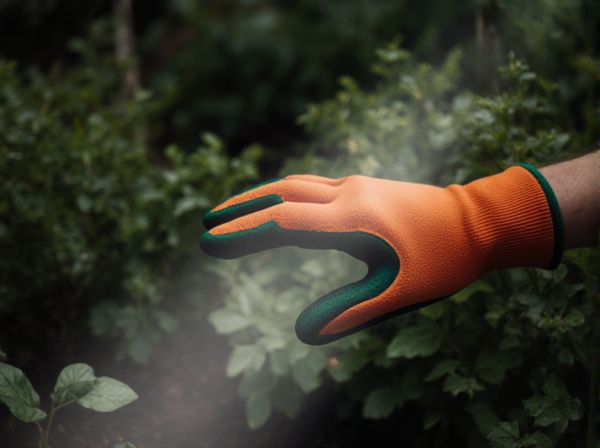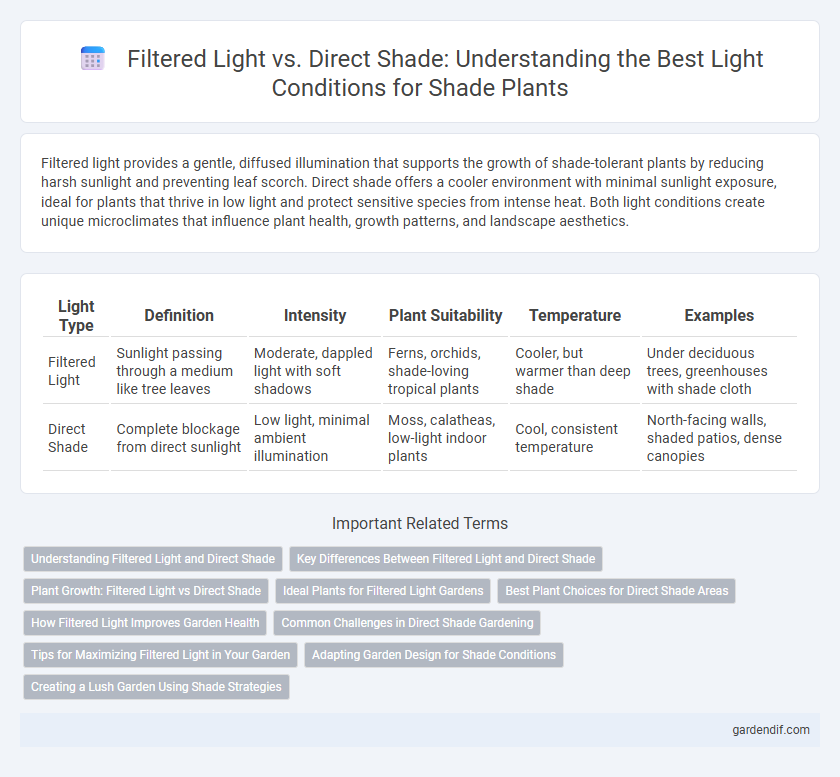
filtered light vs direct shade Illustration
Filtered light provides a gentle, diffused illumination that supports the growth of shade-tolerant plants by reducing harsh sunlight and preventing leaf scorch. Direct shade offers a cooler environment with minimal sunlight exposure, ideal for plants that thrive in low light and protect sensitive species from intense heat. Both light conditions create unique microclimates that influence plant health, growth patterns, and landscape aesthetics.
Table of Comparison
| Light Type | Definition | Intensity | Plant Suitability | Temperature | Examples |
|---|---|---|---|---|---|
| Filtered Light | Sunlight passing through a medium like tree leaves | Moderate, dappled light with soft shadows | Ferns, orchids, shade-loving tropical plants | Cooler, but warmer than deep shade | Under deciduous trees, greenhouses with shade cloth |
| Direct Shade | Complete blockage from direct sunlight | Low light, minimal ambient illumination | Moss, calatheas, low-light indoor plants | Cool, consistent temperature | North-facing walls, shaded patios, dense canopies |
Understanding Filtered Light and Direct Shade
Filtered light occurs when sunlight passes through foliage or other semi-transparent barriers, creating a dappled pattern that reduces intensity while still providing beneficial rays for plant growth. Direct shade refers to areas completely blocked from direct sunlight, offering cooler, low-light conditions that protect shade-tolerant plants from excessive heat and UV exposure. Understanding the differences helps optimize garden planning and plant health by matching species to their ideal light environments.
Key Differences Between Filtered Light and Direct Shade
Filtered light provides diffused sunlight through obstacles like leaves, resulting in softer illumination and reduced heat, which supports the growth of shade-tolerant plants such as ferns and begonias. Direct shade blocks sunlight entirely or partially during prime daylight hours, creating cooler conditions ideal for plants sensitive to intense light, like impatiens and hostas. Understanding the key differences in light intensity, duration, and heat exposure helps gardeners optimize plant health and growth in shaded environments.
Plant Growth: Filtered Light vs Direct Shade
Filtered light provides plants with diffused sunlight, promoting balanced photosynthesis and reducing the risk of leaf scorch, which supports healthier growth in shade-tolerant species. Direct shade limits light intensity significantly, often slowing photosynthesis and retarding growth but benefits plants sensitive to intense light by preventing dehydration and sun damage. Selecting the appropriate light exposure based on a plant's species-specific photosynthetic capacity is critical for optimizing growth and development.
Ideal Plants for Filtered Light Gardens
Filtered light gardens support plants such as ferns, calatheas, and begonias that thrive in dappled sunlight conditions with indirect exposure to the sun. These plants benefit from the gentle interplay of light and shadow, promoting healthy foliage and vibrant colors without the stress of harsh, direct rays. In contrast to direct shade plants, which tolerate deep shadows, filtered light species require moderate illumination to maintain optimal growth and leaf variegation.
Best Plant Choices for Direct Shade Areas
Plants thriving in direct shade include hostas, ferns, and astilbes due to their tolerance for low light conditions and consistent moisture requirements. These species exhibit broad, dark green leaves that maximize photosynthesis under limited sunlight, ensuring robust growth without sunburn risk. Selecting shade-tolerant groundcovers like pachysandra and ivy also helps maintain soil moisture and suppress weeds in densely shaded garden sections.
How Filtered Light Improves Garden Health
Filtered light enhances garden health by providing plants with a balanced exposure to sunlight, reducing the risk of leaf scorch and dehydration common in direct shade. This gentle illumination supports photosynthesis more effectively, promoting vigorous growth and vibrant foliage color. By moderating temperature and light intensity, filtered light also helps maintain soil moisture levels, contributing to overall plant resilience and reduced water stress.
Common Challenges in Direct Shade Gardening
Direct shade gardening often poses challenges such as limited photosynthesis, leading to slower plant growth and reduced flowering. Plants in direct shade may also experience higher humidity levels, increasing the risk of fungal diseases and root rot. Selecting shade-tolerant species and improving soil drainage are essential strategies to overcome these common issues in shaded environments.
Tips for Maximizing Filtered Light in Your Garden
Maximizing filtered light in your garden enhances plant growth by providing a balance of sunlight and protection from harsh rays. Use plants with delicate foliage, such as ferns or hostas, that thrive under dappled sunlight to create a natural canopy. Position reflective surfaces or light-colored mulch to amplify filtered light and maintain soil moisture, promoting healthier and more vibrant plants.
Adapting Garden Design for Shade Conditions
Filtered light creates dappled sunlight conditions ideal for shade-tolerant plants such as hostas, ferns, and astilbes, promoting lush, vibrant garden growth. Direct shade offers cooler, more stable environments that support moisture-loving species like hydrangeas and impatiens, reducing water stress and enhancing color retention. Designing gardens for these shade conditions involves selecting appropriate plant varieties and arranging them to maximize airflow and light penetration, ensuring healthy development and aesthetic appeal.
Creating a Lush Garden Using Shade Strategies
Filtered light provides dispersed sunlight that supports the growth of shade-loving plants, enhancing the lushness of a garden by preventing leaf scorch and promoting vibrant foliage. Direct shade reduces overall light intensity, creating a cool environment ideal for mosses, ferns, and shade-tolerant perennials that thrive in lower light conditions. Employing a mix of filtered light and direct shade enables gardeners to cultivate diverse plant species, ensuring year-round greenery and rich garden texture.
filtered light vs direct shade Infographic

 gardendif.com
gardendif.com